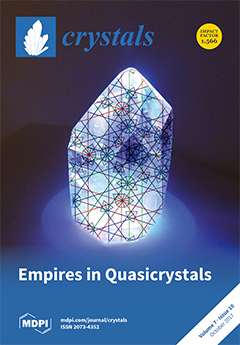A new hydrated benzimidazolium salt containing spiro structure was obtained when benzimidazole is added to ethyl alcohol of 1,5-dioxaspiro[5.5]undecane-2,4-dione and trimethoxymethane. The title compound (C
19H
21O
8) (C
7H
7N
2) (0.5H
2O) was characterized
[...] Read more.
A new hydrated benzimidazolium salt containing spiro structure was obtained when benzimidazole is added to ethyl alcohol of 1,5-dioxaspiro[5.5]undecane-2,4-dione and trimethoxymethane. The title compound (C
19H
21O
8) (C
7H
7N
2) (0.5H
2O) was characterized by elemental analysis, IR, UV-Vis, and single-crystal X-ray diffraction. The result shows that it belongs to the triclinic system, space group P-1, with a = 11.017(2) Å, b = 11.424(2) Å, c = 11.650(2) Å, α = 70.60(3)°, β = 71.00(3)°, γ = 67.64(3)°, Mr = 505.51, V = 1245.2(5) Å, Z = 2, Dc = 1.348 g/cm
3, F(000) = 534, μ(MoKa) = 0.102 mm
−1. There exist two types of hydrogen bonds in the crystal. (C
19H
21O
8)
− anions and (C
7H
7N
2)
+ cations are linked by N–H···O hydrogen bonds, while (C
19H
21O
8)
− anions and free water are linked by O–H···O hydrogen bonds. All of the above hydrogen bonds form a one-dimensional (1D)-chained structure. The 1D chains further links the molecule into a three-dimensional (3D)-layered structure.
Full article





